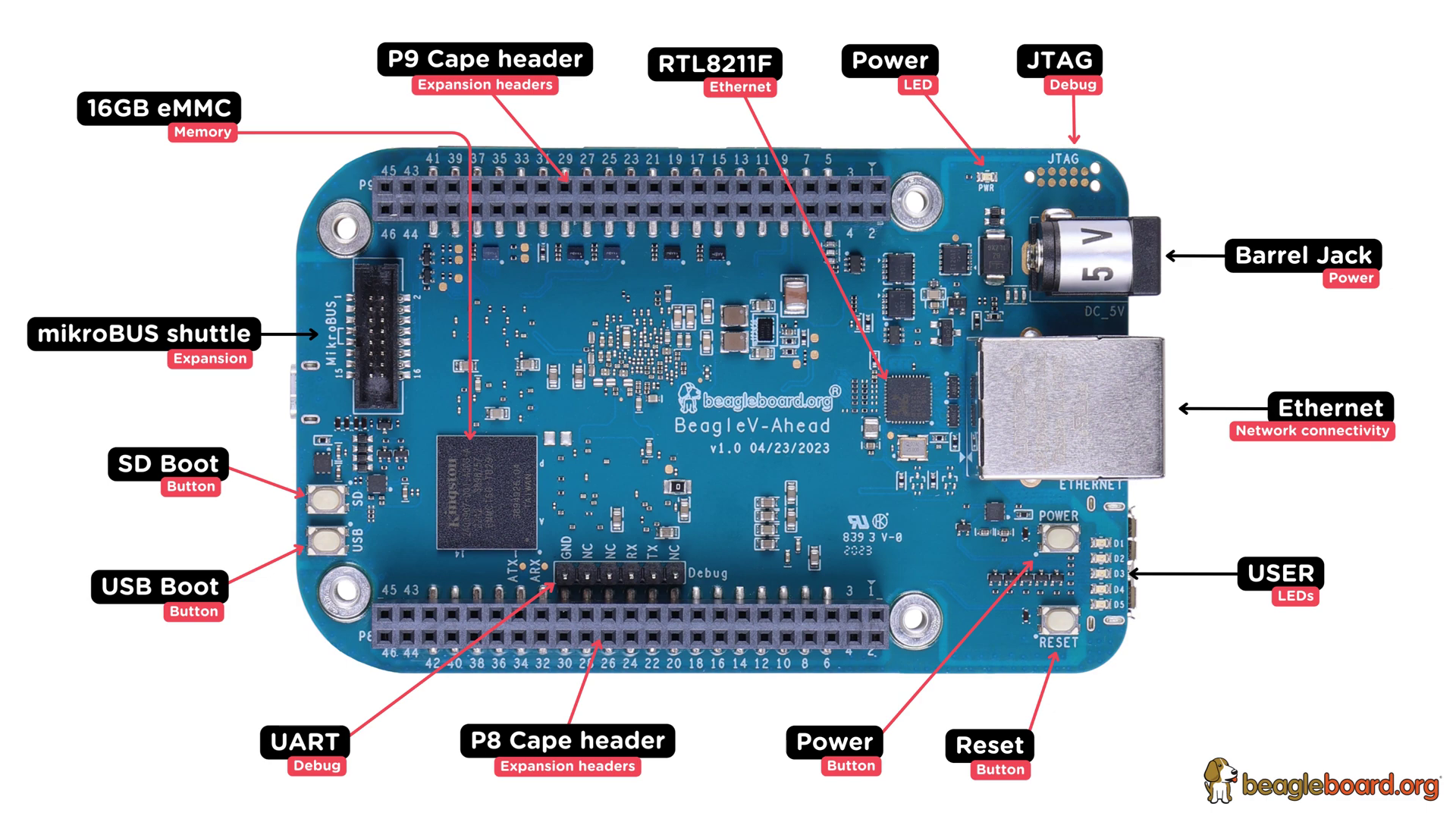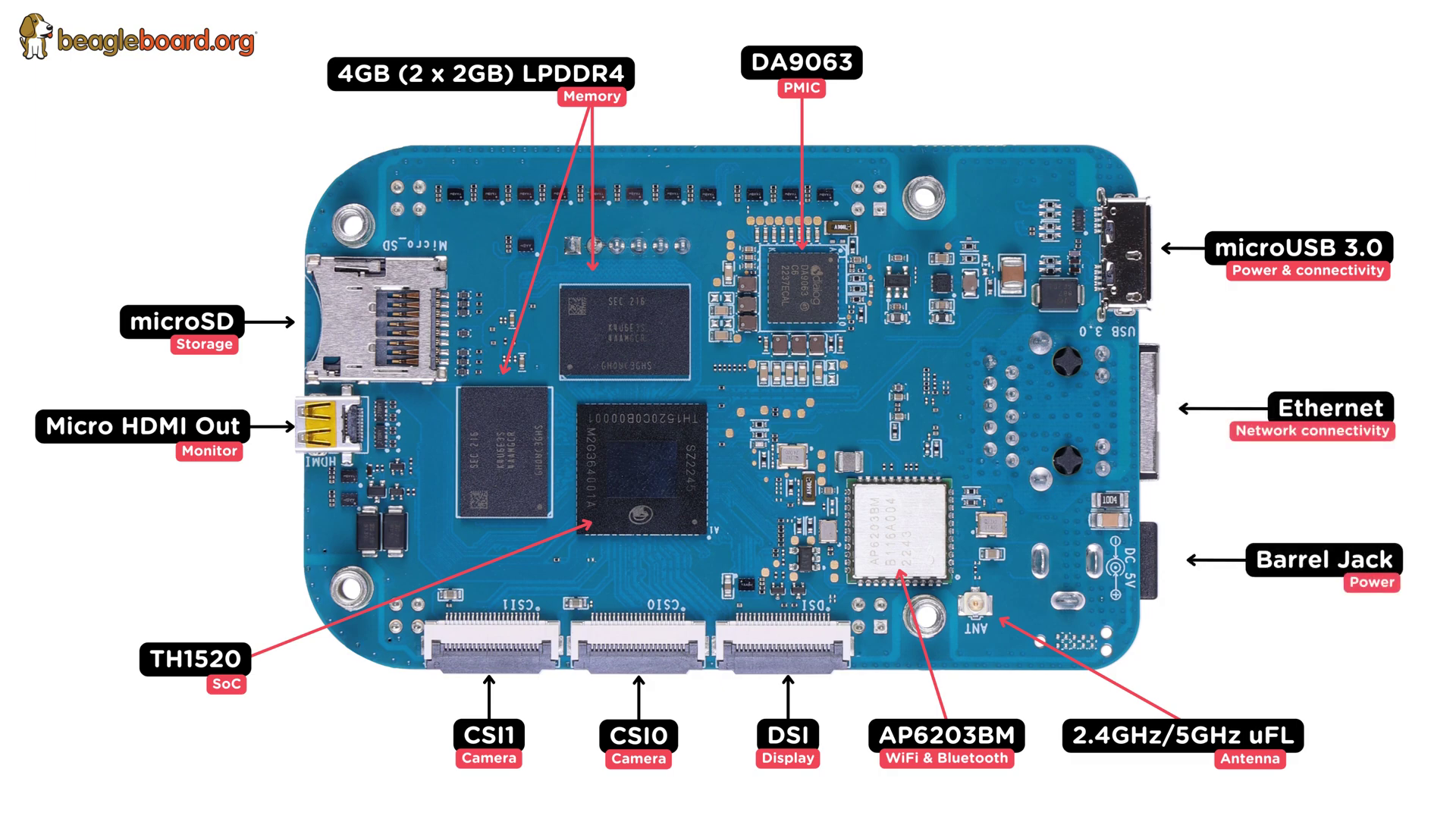BeagleBoard Announce RISC-V Powered BeagleV-Ahead

Raspberry Pi has long been the most famous in the world of single-board computers. But there are plenty of alternatives, such as LattePanda and Khadas, and of course, BeagleBoard, which has announced the availability of its RISC-V powered BeagleV-Ahead.
Coming in at $149, the BeagleV-Ahead is powered by a 2 GHz, quad-core RISC-V 64GCV Xuantile C910 CPU and has 4GB of RAM and 16GB of eMMC flash storage on which you can install either Ubuntu or Yocto Linux. The OS is flashed to the board, and we then remotely interface with the board via a terminal or web interface.
| SoC | Alibaba T-Head TH1520 |
| CPU | 2GHz quad-core RISC-V 64GCV Xuantie C910 |
| GPU | 50GFLOPS, 3Mpixel/s Imagination BXM-4-64 |
| Row 3 - Cell 0 | H.265/H.264 @ 4Kp75 video decoder |
| Row 4 - Cell 0 | H.265/H.264 @ 4Kp40 video encoder |
| NPU | 4TOPS@INT8 neural processing unit (NPU) @ 1GHz |
| RAM | 4GB |
| Storage | 16GB on-board eMMC flash |
| Ports | USB3 super-speed (5Gbps) micro-AB for power and data |
| Row 9 - Cell 0 | micro-HDMI, DSI, 2x CSI |
| Networking | Gigabit Ethernet |
| Row 11 - Cell 0 | Integrated 2.4GHz and 5GHz WiFi |
| GPIO | Standard BeagleBone Layout |
| Row 13 - Cell 0 | Expansion via mikroBUS shuttle, BeagleBone cape headers |
The big draw for this board is the RISC-V CPU. In the maker community, RISC-V is gaining popularity, mainly due to its open-source nature and availability in several different price points and packages. This includes Milk-V, which offers three RISC-V machines starting from $9. You can even get RISC-V-powered soldering irons now!


Beagle boards have used Arm-based CPUs in the past, but the switch to an open-source RISC-V CPU is the only significant change between the boards. The distinct BeagleBoard form factor remains, meaning "capes", BeagleBoard's name for add-on boards (think Raspberry Pi HATs or Arduino Shields). Capes connect to the board using the P8 and P9 header, essentially the same as the Raspberry Pi's GPIO. But with the BeagleV-Ahead, we get six analog inputs and a plethora of PWM, I2C, UART, SPI, I2S and good old digital IO.
The BeagleBoard team has a documentation page up; from there, we can delve deeper into the BeagleV-Ahead. There are a few gaps, but this board is just a few days old, so documentation will eventually catch up.
We first reported on this board in 2021, and in the two years since, there has been a pandemic and a global chip shortage which has impacted the delivery time of the BeagleV. That said, it is good to see another RISC-V board being offered to an enthusiastic maker community.
The BeagleV-Ahead is available from several distributors, with an average price of $149.
Get Tom's Hardware's best news and in-depth reviews, straight to your inbox.

Les Pounder is an associate editor at Tom's Hardware. He is a creative technologist and for seven years has created projects to educate and inspire minds both young and old. He has worked with the Raspberry Pi Foundation to write and deliver their teacher training program "Picademy".
-
bit_user It's overpriced for its performance, but probably good if you really want/need a RISC-V development vehicle and can't score something like the elusive Horse Creek board.Reply
If you just want a fast/capable SBC, I'd prefer an Orange Pi 5 every day of the week. -
Kamen Rider Blade Reply
And another proprietary tinker-board "Form Factor".bit_user said:It's overpriced for its performance, but probably good if you really want/need a RISC-V development vehicle and can't score something like the elusive Horse Creek board.
If you just want a fast/capable SBC, I'd prefer an Orange Pi 5 every day of the week.
It's like they intentionally want to be like Apple and go "Proprietary" anything and don't see the value in sharing a common standardized "Form Factor" or "Eco-System".
Apparently, from the common SBC Form Factors that I've discovered while googling.
Apparently Femto-ITX is a thing -
bit_user Reply
If it's primarily for tinkering, that's less of an issue than if they mean for it to be a mini-PC. At least, as far as I'm concerned. Because, what I really want is an ecosystem where we have lots of mini-PC boards and cases that are interchangeable (and not the Pi's form factor).Kamen Rider Blade said:And another proprietary tinker-board "Form Factor".
Yeah, that might be getting too small. What I'd like to avoid is having an awkward mix of connectors on all sides, simply because it's hard to find any other way to squeeze them all in there. The connector arrangement should basically be like a NUC's.Kamen Rider Blade said:Apparently Femto-ITX is a thing -
Kamen Rider Blade Reply
Basically how Pi & Pi-clones lack any sort of "Standardization".bit_user said:(and not the Pi's form factor).
Their "Standardized" Form Factor = YOLO, we're going to do this for this iteration.
Form-Factor Standards be damned, because we can do it that way, "Just Live With it (Puts on Sun Glasses)".
bit_user said:Yeah, that might be getting too small. What I'd like to avoid is having an awkward mix of connectors on all sides, simply because it's hard to find any other way to squeeze them all in there. The connector arrangement should basically be like a NUC's.
When you start getting into the Pico-ITX size and below, it almost seems impossible to avoid the random mish-mash of connectors on all sides due to how limited the perimeter is and usually the 4x corners of the Rectangle/Square PCB area is usually reserved for screw holes / bolts to place.
So you're really always going to have that weird connector on all sides behavior due to limited work space.
Some "Full-Size" connectors are HUGE, especially legacy ports that you want placed on it.
Short of using ONLY modern connectors that are physically tiny, you have to make a choice based on what board you pick and where the connectors are pre-mounted or where you want to place them if you do have an option.
